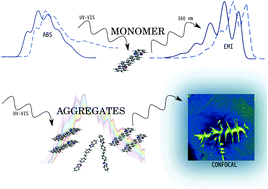A 4,4′-bis(2-benzoxazolyl)stilbene luminescent probe: assessment of aggregate formation through photophysics experiments and quantum-chemical calculations†
Abstract
A combination of experimental and quantum mechanical investigations is applied to the study of the optical features of 4,4′-bis(2-benzoxazolyl)stilbene (BBS) dissolved in solution or in a poly(L-lactic acid) (PLA) thermoplastic matrix at different concentrations. The experimental analyses allow the characterization of BBS solutions and dispersions in terms of absorption and emission features, along with the collection of some key parameters such as fluorescence quantum yield, anisotropy and lifetime, while the computational approach gives a detailed description of the photophysical behavior of BBS in the different environments. For the 10−5 M BBS solution, the fluorescence spectra show the expected peaks at 425 and 455 nm of the non-interacting BBS molecules with a single fluorescence lifetime of 0.85 ns without revealing any aggregation phenomena, prevented by the short lifetime and fast diffusion rate of the monomer. Moreover, the calculated spectra are in excellent agreement with the experiments, thus showing the reliability of the computational approach. In time-resolved emission experiments (TRES) on more concentrated solutions (10−4 M) and on BBS crystals, the presence of an excimer is revealed by the appearance of a broad peak around 540 nm, followed by the disappearance of the two main peaks at 460 nm on a time scale of about 10 ns. The computational analysis attributes this behavior to the formation of aggregates of different geometries. The BBS dispersions in PLA reveal the presence of different BBS architectures depending on the fluorophore content. Even at low concentrations, BBS is mainly dispersed as a monomer in the matrix, spheroid aggregates of about 800–900 nm in diameter are also present and the relevant fluorescence spectra arise from the combination of monomer and aggregate contributions. At higher concentrations, BBS starts forming crystals of a peculiar helicoidal shape, with a diameter of about 2 μm, variable length up to several hundreds of μm and emission spectra similar to those of isolated BBS crystals.

- This article is part of the themed collection: 2018 PCCP HOT Articles


 Please wait while we load your content...
Please wait while we load your content...